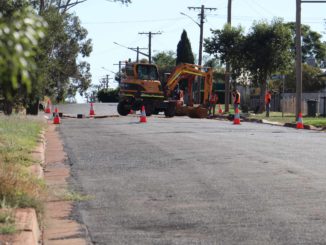
areas of Australia
A tropical bird that’s more at home in the Northern Territory, the Jabiru, was spotted just west of Cobar last week.
Local landholder Graeme Barton reports that he saw (and photographed) the bird, which he later identified as a Jabiru, feeding on the side of the Barrier Highway about 10km west of Cobar last Wednesday.
“It’s definitely lost,” he said.
Graeme said he saw the bird, which stands about a metre high, a number of times last week while he was travelling to and from his property to town.
The Jabiru can usually be found high up in Western Australia, across northern Australia and inland Queensland, although there have been some recordings of the bird being as far south as the north-west plains of NSW.
Local amateur ornithologist John Martin
said he’s never heard of Jabirus in the Cobar area.
“The Jabiru, our only native crane, is generally found in the far flung parts of the Northern Territory,” John said.
“This one seems to be lost.
He said years ago there used to be Brolgas and Bush Turkeys in the area but he said they haven’t been seen for a good number of years.
“It’s had a lot to do with the way the land was grazed back 50,60,70 years ago.
“Overgrazing led to a lot of woody weed coming in,” John said.
He suggested the Jabiru has ended up this far south as he’s looking for food.
“If there’s one, there may be others,” John said.
“Birds will migrate to where they can get a feed.
“We’ve probably had 10 inches of rain this year which has made an enormous difference.”
John said he’s recently noticed big crimson wing parrots in prolific numbers.
“You can also see a lot of Blue-faced Honeyeaters, which are Queensland rainforest birds, around now.”
He’s noticed native grass parrots are already nesting, which he said is totally out of season as they usually breed in spring.
John said his parrots, which haven’t bred for the past three years due to the drought, have recently started breeding again.
“It’s got a lot to do with food and humidity,” he said.
The influx of birds to Cobar (including the Jabiru) may be because of rain but it may also have something to do with COVID-19.
With many countries in lockdown, birds (and other animals) have been inhabiting the spaces normally occupied by humans.
Mumbai, in India, has recently experienced an influx of flamingos as it’s believed the birds now have more space to congregate and their food supply has stabilised.
